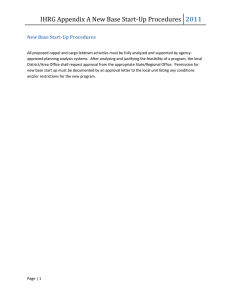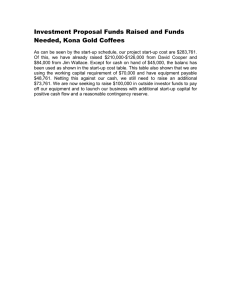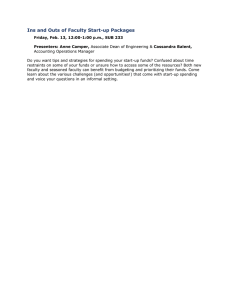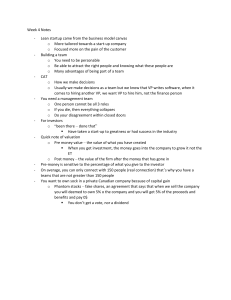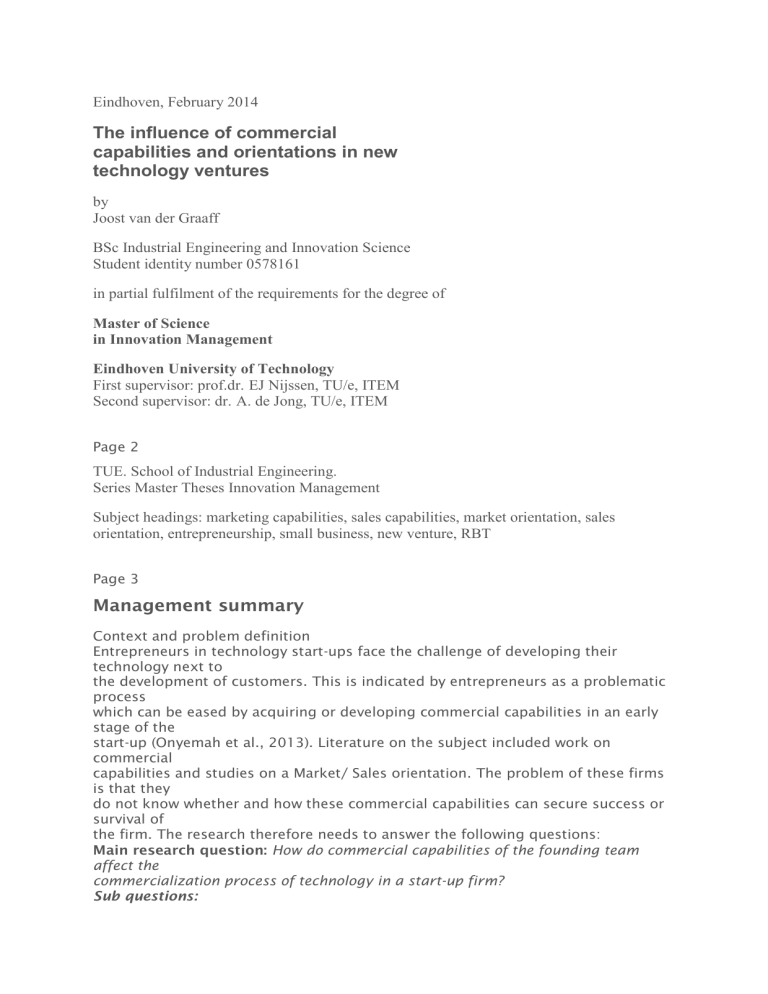
Eindhoven, February 2014 The influence of commercial capabilities and orientations in new technology ventures by Joost van der Graaff BSc Industrial Engineering and Innovation Science Student identity number 0578161 in partial fulfilment of the requirements for the degree of Master of Science in Innovation Management Eindhoven University of Technology First supervisor: prof.dr. EJ Nijssen, TU/e, ITEM Second supervisor: dr. A. de Jong, TU/e, ITEM Page 2 TUE. School of Industrial Engineering. Series Master Theses Innovation Management Subject headings: marketing capabilities, sales capabilities, market orientation, sales orientation, entrepreneurship, small business, new venture, RBT Page 3 Management summary Context and problem definition Entrepreneurs in technology start-ups face the challenge of developing their technology next to the development of customers. This is indicated by entrepreneurs as a problematic process which can be eased by acquiring or developing commercial capabilities in an early stage of the start-up (Onyemah et al., 2013). Literature on the subject included work on commercial capabilities and studies on a Market/ Sales orientation. The problem of these firms is that they do not know whether and how these commercial capabilities can secure success or survival of the firm. The research therefore needs to answer the following questions: Main research question: How do commercial capabilities of the founding team affect the commercialization process of technology in a start-up firm? Sub questions: What is the role and influence of a customer orientation in the commercialization process of a technology start-up firm? What is the role and influence of a competitor orientation in the commercialization process of a technology start-up firm? What is the role and influence of a sales orientation in the commercialization process of a technology start-up firm? This research addresses issues raised by The Holst Centre, an independent openinnovation R&D centre, regarding the exploitation of their commercialization via new ventures. We therefore extended the data and model of Witte (2012), a research initiated earlier to address these issues The Holst Centre. With limited studies on entrepreneurship, this research takes both small established firms and small entrepreneurial firms, start-ups, into account who share many of their marketing problems. I Page 4 Literature background A literature review was executed with the following keywords: commercial capabilities , entrepreneurship, small firms, sales, marketing or combinations thereof. This identified two literature streams: 1. Commercial capabilities in small and start-up firms This literature stream on commercial capabilities reasons from the Resource Based Theory (RBT) and suggests that capabilities are needed to recognize unique resources within a firms and transform these resources into customer value (Amit and Schoemaker, 1993; Day, 1994) . In small firms and start-ups, these capabilities mainly involve the founding team. Research has mainly focused on marketing capabilities, but recent attention has also focused on the influence of possessing sales capabilities within the founding team. Furthermore, several studies reason according to the RBT that marketing and sales capabilities in itself do not deliver a competitive position in the market place and these capabilities influence the business performance in relation to the culture of an organization, ie a market or sales orientation. Ambiguity exists on the type of relation between these commercial capabilities and orientations and especially literature on small and start-up firms regarding this topic is undeveloped. 2. Market/ Sales orientation& customer development in small and start-up firms The second research stream includes publications on the level and benefit of market and sales orientation in small and start-up firms. The results of these studies reveal that these firms mainly rely on their customers for the acquisition of market information (Blankson and Cheng, 2005; Blankson et al., 2006). The vital role of the customer has been highlighted by studies on the importance of having a reference customer as a small or start-up firms, who can refer the firm to other customers on the market . With little experience in customer relationship building, researchers argue that the sales activities of a firm are crucial to connect with these customers. Therefore, recent attention has focused on the benefit of a sales orientation, next to an MO, in small and start-up firms. Focusing on learning from the customer via sales and thus integrating sales in the NPD process is seen by researchers as an important determinant for start-up success. Responding to the feedback of the customer acquired with sales activities is done best by acquiring minimal resources and thereby launching lean. II Page 5 Conceptual model The following model was created to guide this research: We have developed a model in which we combine the two literature streams. The first stream of articles regarding commercial capabilities in small and start-up firms is represented in the bottom half of the model. The articles concerning an MO/SO and customer development are shown in the upper half of the model in which the components of an MO/SO are included separately. To combine these two streams we built on Morgan et al. (2009) who have also studied the interaction between commercial capabilities and MO/SO in general. We on the other hand focussed on the start-up context discussed in the previous section and distinguished between marketing and sales capabilities, but also shared interpretation of the market information by the founding team. Methodology To test the newly developed model the original data set of Witte (2012) was extended from 35 to 68 cases, enhancing for instance also the measure for the level of technology push. The model was tested with a sample of Dutch spin-offs and spinouts involved in technology based innovations. We used a SEM based partial least square method to analyse the hypotheses. III Page 6 Results The reliability and validity of the measures was analysed and the hypotheses were tested. Validity of the model resulted in 4 of 13 supported hypotheses. The main hypothesis was supported, indicating a positive significant influence of founding team commercial capabilities on the business performance. When commercial capabilities are combined with a competitor orientation, this will benefit the performance even more. A combination of commercial capabilities and a low customer orientation benefits the business performance as well. No support could be found for an influence of a customer or sales orientation on the business performance. The results did show a significant positive effect of a competitor orientation on the business performance of a start-up. Monitoring the developments of the competitors and knowledge on whether the customers of the competitors are satisfied delivers a benefit for survival and growth of a start-up. Several other interaction effects are identified as well. A high orientation on the customer and sales only influences the business performance under a low share interpretation by the founding team. The results also show that when a startup is highly driven by technology, the firm's performance benefits even more from an orientation towards the competitor. Discussion As hypothesized, commercial, ie marketing and sales, capabilities enable the founders to recognize valuable market information and turn this information into customer value. The positive influence of commercial capabilities on the performance of the start-up is dependent on the level of competitor and customer orientation. First, being commercially capable seems particularly important when little information about the customer is available and the start-up has little insights in the existing or latent needs of the customer. Second, when the start-up has a high focus on the competitor, the information of the competitor needs to be interpreted with the use of the commercial capabilities of the founders and transformed into useable information. No direct effects of having a customer and sales orientation could be found, in contrary to our hypotheses and findings of prior studies (Blankson and Cheng, 2005; Ruokolainen, 2005). It seems that predicting customer needs is a more difficult process for startups than assumed by researchers. An explanation could be the false assumption of a predictable and an effectual marketing approach might be more suitable for start-ups (Sarasvathy, 2001). Having an organization-wide traditional causational orientation towards customer and the selling activities might therefore not deliver a benefit for the business performance of the startIV Page 7 ups. They should rather rely on the competitor for their information instead of their customer or sales activities. With a high focus on the customer, start-ups might become over dependent on their customer and lose the beneficial focus on the competitor. It seems that startups should mind the strategy of the competitor in order to determine the direction of the technology on the market, or certain technology paths. This is in line with the results on the level of technology push of the start-ups which indicate that especially start-ups who are driven by technology benefit from a focus on the competitor. Especially these start-ups should mind the technology strategy of the competitor and adapt their innovations accordingly. How the information is interpreted by the founding team has a significant influence on the benefit of a commercial orientation. When a start-up is involved in the process of customer involvement, this process should not be interrupted with frequent meetings that can distort this process. What might happen, is that the more traditional marketing and sales functions interrupt the process by trying to convince the founding team with their own collected market information. It is however beneficial to meet frequently and create a shared interpretation when the start-up has a low focus on the customer and its selling activities and little customer and sales information available. V Page 8 Preface This thesis marks the completion of my Master Innovation Management at the Eindhoven University of Technology. The writing of this thesis has been going through some ups and downs with the last mile as hardest. The passion of the entrepreneurs participating in my research kept me motivated throughout the whole process. With a life-long dream of starting a business on my own, I was more than happy to take a quick glance in the mind of the entrepreneur, characterized by endless persistence. I am grateful towards several people which supported me during my research. Therefore, I would like to thank Ed Nijssen for keeping me focused and stimulating me to take a critical standpoint regarding my research. In our meetings he was able to give me direct feedback and quickly identify problems, leading to a better quality of the output. He taught me to look at my thesis in a structured way, accompanied with a large dose of common sense. Furthermore, I would like to thank Ad de Jong for providing an alternative and creative point of view on my work. I also want to thank Erwin Meinders from TNO Holst Centre for providing the basis of this research. Finally, I would like to thank my family and friends for the unconditional support during my research. Joost van der Graaff, Eindhoven, February 2014 VI

